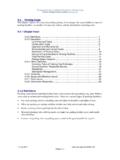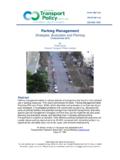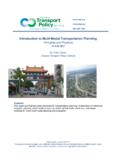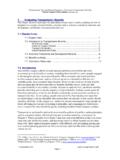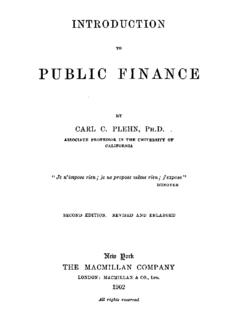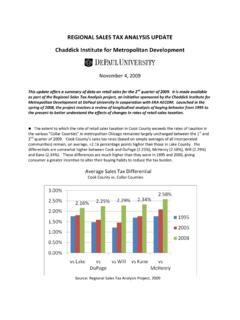Transcription of Local Funding Options for Public Transportation
1 250-360-1560 Todd Litman 2013-2017 You are welcome and encouraged to copy, distribute, share and excerpt this document and its ideas, provided the author is given attribution. Please send your corrections, comments and suggestions for improvement. Local Funding Options for Public Transportation 18 July 2017 By Todd Litman Victoria Transport Policy institute Abstract This report evaluates eighteen potential Local Funding Options suitable to help finance Public transit or other Transportation projects and services. They are evaluated according to eight criteria, including potential revenue, predictability and sustainability, horizontal and vertical equity, travel impacts, strategic development objectives, Public acceptance and ease of implementation. This is a somewhat larger set of Options and more detailed and systematic evaluation than most previous studies.
2 This research identified no new Options that are particularly cost effective and easy to implement; each has disadvantages and constraints. As a result, its overall conclusion is that a variety of Funding Options should be used to help finance the Local share of Transportation improvements to ensure stability and distribute costs broadly. A summary version of this report was published as: Evaluating Public Transportation Local Funding Options , Journal of Public Transportation , Vol. 17, No. 1, 2014, pp. 43-74 Local Funding Options for Public Transportation Victoria Transport Policy institute 2 Contents Introduction .. 3 Literature Review .. 3 General Transportation Funding (not specific to transit) .. 3 Transit Funding Studies .. 4 Evaluation Criteria .. 9 Potential Revenue .. 9 Predictability and Stability.
3 9 Equity Analysis .. 9 Travel Impacts ..10 Strategic Development Objectives ..10 Public Ease of Implementation ..11 Analysis .. 12 Fare Increases ..12 Discounted Bulk Transit Passes ..14 Property Taxes ..15 Regional Sales Taxes ..16 Income Taxes ..17 Fuel Taxes ..18 Vehicle Levy ..19 Utility Levy ..19 Employee Levy ..21 Road Tolls ..22 Vehicle-Km Tax ..23 Parking Sales Parking Levy ..25 Expanded Parking Pricing ..26 Development or Transportation Impact Fees ..27 Land Value Station Rents ..29 Station Air Rights ..30 Advertising ..31 Options Summary .. 32 Conclusions .. 35 Bibliography .. 37 Acknowledgments .. 43 Local Funding Options for Public Transportation Victoria Transport Policy institute 3 Introduction High quality Public transit can provide various economic , social and environmental benefits, including direct user benefits and various indirect and external benefits.
4 Residents of communities with high quality transit tend to own fewer motor vehicles, drive less, and spend less on transport than they would in more automobile-oriented locations. Governments and businesses can save roadway and parking facility costs. It can support economic development. Appropriate Public transit investments can provide positive economic returns: under favorable conditions transit investments can provide savings and benefits that more than offset costs (Litman 2010). As a result, Public transit service improvements are an important component of many jurisdictions strategic transport plans (Buehler and Pucher 2010). Dedicated fuel taxes and vehicle fees finance highway programs, developers are required to build vehicle parking facilities, and freight provides good profits to most railroads; Public Transportation lacks such reliable Funding Options (Yusuf 2016).
5 Although federal and state/provincial funds often help finance transit improvements, additional Local Funding is generally needed. Several previous studies identify and evaluate potential Funding Options for transport (AASHTO 2014; Huang, et al 2010; Sakamoto 2010; Reich, Davis and Sneath 2012) and Public transit (DeGood 2012; IPIRG 2007; Pula, Shinkle and Rall 2015; Smith and Gihring 2015; TBoT 2010; TCRP 2009), but many only consider a limited set of Options and evaluation criteria. This report evaluates eighteen potential Local Funding Options according to eight criteria, including potential revenue, predictability and sustainability, horizontal and vertical equity, travel impacts, strategic development objectives, Public acceptance and ease of implementation. This is a somewhat larger set of Options and evaluation criteria than considered in most previous studies.
6 Much of this analysis can be applied to other types of Transportation improvements besides Public transit. Literature Review This section summarizes various publications on Transportation and Public transit Funding Options . General Transportation Funding (not specific to transit) Sustainable Urban Transport Financing from the Sidewalk to the Subway: Capital, Operations, and Maintenance Financing (Ardila-Gomez and Ortegon-Sanchez 2016) identifies an underfunding trap in which cities lack sustainable revenue to implement Transportation improvements that will provide long-term savings and benefits. They evaluate 24 potential financing instruments based on their social, economic and environmental impacts, their ability to fund urban transport capital investments, operational expenses, and maintenance, and the beneficiary pays principle.
7 They conclude that capital investments should be financed by a combination of grants from multiple levels of government, loans, Public private partnerships repaid by user fees, and property taxes. Transportation Revenue Options : Infrastructure, Emissions, and Congestion (Huang, et al 2010), summarizes results of an expert workshop on Transportation Funding . It considers three main Funding categories: fuel taxes, congestion fees and VMT fees. It explores the financial and environmental advantages and disadvantages of each option and discusses various policy issues. It highlights the additional benefits of road tolls and vehicle-travel fees which can reduce traffic congestion and pollution emissions, in addition to raising revenues. Financing Sustainable Urban Transport (Sakamoto 2010) provides guidance on urban transport finance, particularly in developing countries.
8 It evaluates various Funding Options based on administrative levels, potential revenues, efficiency, equity, environmental objectives, stability, political acceptability and administrative ease. It also provides numerous examples and case studies from around the world. Local Funding Options for Public Transportation Victoria Transport Policy institute 4 Florida MPOAC Transportation Revenue Study (Reich, Davis and Sneath 2012) summarizes a detailed study which analyzed key state Transportation Funding issues, identified and evaluated potential sustainable Funding sources. It recommends dedicated sales taxes, increased diesel taxes, gradually increase gasoline taxes and index them to inflation, redirect motor vehicle license and title fees to the state Transportation funds, and conduct a study of VMT fees for possible future implementation.
9 Innovative Infrastructure Financing Mechanisms for Smart Growth (Tomalty 2007) describes and evaluates infrastructure (including but not limited to Public transit improvements) Funding Options that support smart growth development. It includes examples from various cities. These include: High Occupancy/Toll Lanes Sector and Density Gradient Approach to Development Cost Charges Parking Site Tax Land Value Taxation Standard Offer Contract Storm Water Utility Fee Credits TOD Policy Leveraging Fuel Tax Transfer Tax Increment Financing Tax Base Sharing Vehicle Registration Surcharges Commuter Tax Tax-Exempt Tax Revenue Bonds Local Option Sales Tax Grant Anticipation Revenue Vehicles Transit Funding Studies Local and Regional Funding Mechanisms for Public Transportation and its online Regional Funding Database (TCRP 2009) provides an extensive list of Local and regional Funding sources that are or could be used to support Public Transportation , plus guidance on factors to consider when evaluating and implementing these Options .
10 Table 1 summarizes the Options identified. It evaluates based on revenue yield (adequacy and stability), cost efficiency, equity across demographic and income groups, degree to which beneficiaries pay, political and popular acceptability, and technical feasibility. Table 1 Local and Regional Public Transport Funding Options (TCRP 2009) Traditional Tax- and Fee-Based Transit Funding Sources Common Business, Activity, and Related Funding Sources Revenue Streams from Projects ( Transportation and Others) New User or Market-Based Funding Sources General revenues Sales taxes (variable base of goods and services, motor fuels) Property taxes (real property, includes vehicles) Contract or purchase-of-service revenues (by Public agencies and private organizations, etc.) Lease revenues Vehicle fees (title, registration, tags, inspection) Advertising revenues Concessions revenues Employer/payroll taxes Vehicle rental and lease fees Parking fees Realty transfer tax and mortgage recording fees Corporate franchise taxes Room/occupancy taxes Business license fees Utility fees/taxes Income taxes Donations Other business taxes Transit-oriented development/joint development Value capture/beneficiary charges Special assessment districts Community improvement districts/community facilities districts Impact fees Tax-increment financing districts Right-of-way leasing Tolling (fixed, variable, and dynamic; bridge and roadway) Congestion pricing Emissions fees VMT fees Various potential Funding Options are described in a Transit Cooperative Research Program (TCRP) report.

